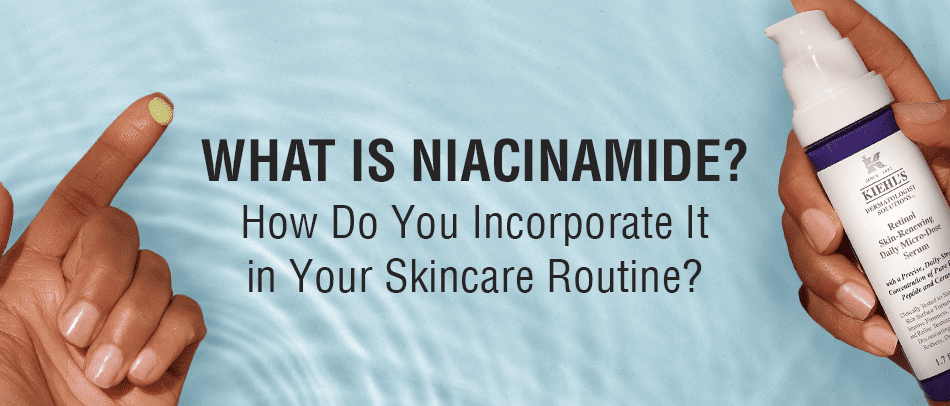Building a skincare routine is a struggle when you have acne-prone skin. It’s difficult to find products that work for you because the trial-and-error method of buying skincare puts your skin through the wringer. Even the tiniest amount of the wrong product can trigger a massive breakout.
That’s why it’s essential to study the ingredients in skincare products. This way, you can avoid elements that trigger breakouts and choose ones that soothe and prevent acne.
And if there’s one all-around, crowd-pleaser ingredient in skincare, it’s niacinamide. It’s a super vitamin that suits almost every skin type but is especially loved by those with acne-prone skin.
Keep reading the article to discover how niacinamide helps reduce and prevent stubborn pimples and blemishes.
What is Niacinamide?
Niacinamide (or nicotinamide) is a form of vitamin B3, an essential nutrient responsible for skin, kidneys, and brain care. What makes it a powerhouse skincare ingredient is its ability to build proteins in the skin and lock in moisture for several hours to lessen environmental damage.
Niacinamide is naturally found in your body but is also present in foods like green vegetables, eggs, fish, beans, and milk. While taking in vitamin B3 is beneficial to the skin, the small intestine does not fully absorb it. This factor is why dermatologists suggest applying niacinamide directly to the skin for the best results.
5 Niacinamide Skincare Benefits
- Treats and prevents acne: Acne is an inflammatory condition, and this inflammation produces numerous pimples with delayed healing and acne scarring. Using niacinamide will reduce the overall inflammatory reaction of your pimples, which speeds up healing.
- Regulates oil production: Our skin has sebaceous glands, which are responsible for producing sebum, an oily substance that coats and protects the skin from external stressors. Many people prone to acne also have oily skin, meaning their sebaceous glands produce too much sebum. Applying niacinamide can help regulate oil production and prevent pimples.
- Fades hyperpigmentation: Niacinamide is a proven remedy for various pigmentation issues like dark spots, acne scars, discoloration, brown patches, and melasma. A sunscreen mixed with just 2% niacinamide can lead to visible hyperpigmentation improvements in just four weeks.
Deeper skin tones are not excluded from niacinamide skin benefits. A study revealed that Indian women who used a cream with 4% niacinamide, 0.5% provitamin B5, and 0.5% vitamin E resulted in reduced hyperpigmentation and a more even skin tone within 6 to 10 weeks. - Reduces redness and inflammation: People with eczema, rosacea, acne, and other inflammatory skin conditions will benefit from niacinamide’s anti-inflammatory properties.
- Minimizes the appearance of pores: While there is still no solid research on B vitamins and pore size, preliminary studies suggest that niacinamide has a “normalizing” ability on pores that have enlarged due to debris or sun damage. Niacinamide helps pores return to their normal size and tighten them by enriching the skin’s supportive elements.
How to Use Niacinamide
Since niacinamide is an all-around skincare ingredient, you can find it in most toners, serums, moisturizers, and sunscreens. Serums have the highest niacinamide concentration, so they’re ideal for addressing specific skin concerns, like pimples and dark spots.
Niacinamide, although a potent ingredient, is safe to use every day. But if this is your first time using niacinamide, it’s best to apply it only twice or thrice a week and slowly build the frequency up once your skin acclimates to it.
Some skincare products are best applied day and night or both. Check the directions on your niacinamide product beforehand.
Another great thing about niacinamide is that it works better when combined with other active skincare ingredients. For example, your acne-prone skin can pair a niacinamide product with salicylic acid, a beta-hydroxy acid used in most acne products.
To reduce inflammation and strengthen your skin barrier, use a niacinamide combination with alpha-hydroxy acids (AHAs). AHAs can exfoliate dead skin cells that hinder the niacinamide from performing effectively. To hydrate dry skin, you can pair niacinamide with hyaluronic acid as they’re both water-based ingredients that cause no serious side effects.
For acne-prone skin, the best combination is niacinamide and retinol. Retinol is known for treating and preventing acne and improving skin texture, so pairing it with niacinamide can give you the skin clarity you’re aiming for. Kiehl’s Microdose Retinol Serum has both niacinamide and retinol in one bottle, so it’s perfect if you’re struggling with acne and stubborn pimple scars.
A retinol skincare routine also keeps your skin bouncy and youthful-looking because it delays the appearance of wrinkles and fine lines.
Next-Level Skincare with Niacinamide
You are missing out if you still don’t have niacinamide in your skincare arsenal. The versatility of this B vitamin deserves a spot in the list of best skincare ingredients everyone needs in their routine.
Remember to choose products and ingredients that work for your skin and target specific skin issues. You can message Kiehl’s on Facebook when selecting the right skincare products. Our customer representative will give you a personalized recommendation based on your skin type and concerns.
Shop Kiehl’s Microdose Retinol Serum today and see blemish-free skin in weeks.

